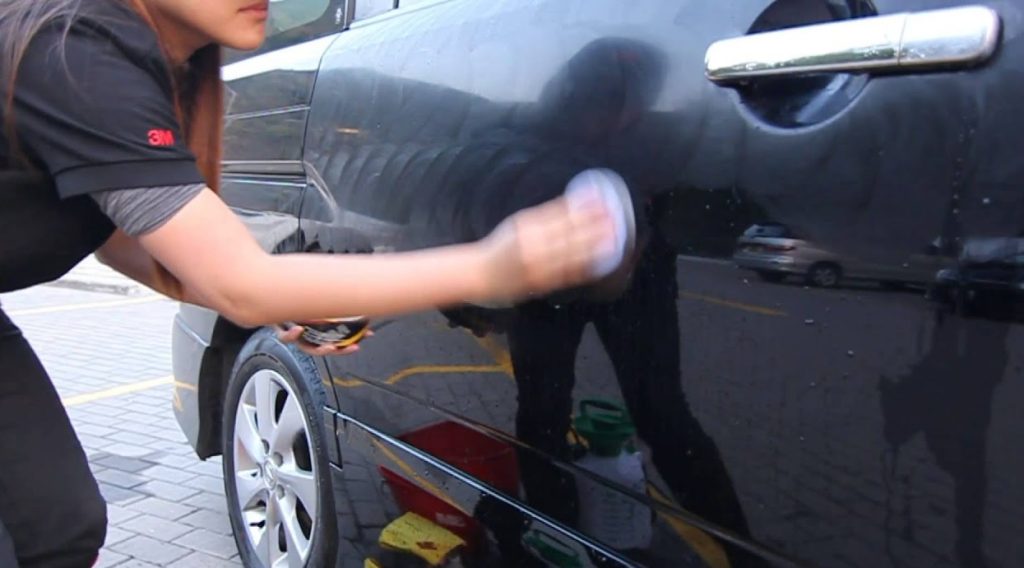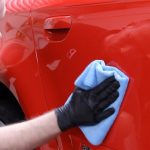The frustration of discovering buffing compound lodged in the cracks of your car can be overwhelming. Fear not, fellow car enthusiasts! In this in-depth guide, we’ll delve into effective methods to eliminate buffing compound remnants and restore your vehicle’s pristine appearance. Let’s explore this issue step by step, ensuring your car shines like new.
Understanding the Challenge
Buffing Compound Composition: Buffing compound, a blend of abrasives and lubricants, is designed to enhance a car’s finish. However, its fine particles can find their way into the smallest crevices during the buffing process.
Surface Variation: The diverse surfaces of a car, featuring curves, edges, and intricate details, pose a challenge. Buffing compound residue tends to settle in these areas, demanding a careful and detailed approach to removal.
Essential Tools and Materials
To tackle this problem effectively, you’ll need a set of tools and materials readily available:
- Soft Bristle Brush: This tool allows you to reach into tight spaces without causing damage to the car’s finish. Choose a brush with bristles that are both soft and effective.
- Microfiber Cloths: Gentle on the paint but effective in removing residue, microfiber cloths are a staple in the detailing process. They aid in wiping away particles without leaving scratches.
- Detailing Clay: When buffing compound proves stubborn, detailing clay becomes your ally. Its adhesive properties help lift embedded particles, providing a smooth surface.
- Q-Tips or Cotton Swabs: For precision cleaning in intricate areas, Q-tips or cotton swabs are indispensable. Dip them in isopropyl alcohol for targeted cleaning.
- Isopropyl Alcohol: An effective solvent, isopropyl alcohol aids in dissolving buffing compound, making it easier to wipe away.
Step-by-Step Removal Process
1. Inspect the Area
Start by closely inspecting the affected areas. Take note of the extent of buffing compound penetration and check for any potential damage to the surrounding paint.
2. Gentle Brushing
Use a soft bristle brush to gently sweep away loose particles. Begin from the outer edges and work your way toward the center. This helps prevent spreading the residue.
3. Microfiber Wipe Down
Employ a microfiber cloth to wipe down the area. This step not only removes finer particles but also provides a clear view of any remaining residue that requires attention.
4. Detailing Clay Application
For persistent residue, apply detailing clay. Glide it over the affected surface, allowing the clay to pull out embedded particles. Regularly fold and knead the clay to expose a fresh, clean surface.
5. Q-Tip Precision
Dip a Q-tip or cotton swab in isopropyl alcohol and carefully target hard-to-reach areas. The precision of this method ensures a thorough cleaning without affecting surrounding surfaces.
6. Repeat as Needed
Repeat the entire process until all traces of buffing compound are eradicated. Patience is key in achieving a flawless outcome, especially in intricate areas.
Preventive Measures
– Masking Off Cracks:
Before beginning the buffing process, use masking tape to cover vulnerable areas like cracks. This precautionary step minimizes the chances of compound settling in hard-to-reach spaces.
– Adjusting Buffing Pressure:
Be mindful of the pressure applied during buffing. Excessive pressure can lead to compound spreading into cracks. Opt for a controlled and even application. (See Also: Does Carnauba Wax Go Bad? Expert Answers and Tips for Proper Storage)
– Frequent Inspections:
Regularly inspect your car for residue, addressing it promptly. This proactive approach ensures that any compound buildup is dealt with before it becomes a more significant issue.
Additional Tips and Tricks
– Use a Blower or Compressed Air:
For cracks that are difficult to reach, a blower or compressed air can help dislodge particles. Exercise caution to avoid damaging the paint.
– Opt for a Professional Detailing Service:
If the situation seems challenging or if you prefer a hands-off approach, consider seeking the expertise of a professional detailing service. They have the tools and experience to tackle complex detailing tasks.
– Apply a Sealant or Wax:
After thorough cleaning, consider applying a quality sealant or wax to protect the exposed surfaces. This not only enhances the shine but also adds a layer of defense against future contaminants.
Expert Tips: Mastering Buffing Compound Removal Like a Pro
When it comes to achieving a flawless finish on your car, dealing with buffing compound in cracks demands expertise. Let’s explore some expert tips to elevate your detailing game and ensure your vehicle sparkles without a trace of residue.
1. Early Detection is Key
Detecting buffing compound early reduces the likelihood of it settling into cracks. Regularly inspect your car after any detailing session, paying special attention to intricate areas.
2. Precision Tools Matter
Invest in high-quality, precision tools like fine-bristle brushes and detailing clay. These tools allow you to target specific areas without causing damage, ensuring thorough and effective removal.
3. Patience in Detailing
Detailing is an art that requires patience. Take your time during the removal process, especially in hard-to-reach places. Rushing may lead to oversight and compromise the final result.
4. Vary Your Cleaning Techniques
Different cracks may require different cleaning techniques. Experiment with various tools and methods to find the most effective approach for each unique area of your vehicle.
5. Consider Compressed Air
A controlled burst of compressed air can dislodge stubborn particles from tight spots. Use this sparingly and at a safe distance to avoid inadvertently causing damage to the paint.
6. Professional Assistance When Needed
Don’t hesitate to seek professional detailing services, especially for intricate or challenging cases. Experienced detailers have the expertise and tools to handle complex situations with finesse. (See Also: How to Remove Dried Buffing Compound: Quick Tips for a Flawless Finish)
7. Seal the Deal with Sealant
After thorough cleaning, apply a high-quality sealant to the cleaned surfaces. This not only enhances the shine but acts as a protective barrier, minimizing the chances of future residue accumulation.
8. Learn from Each Detailing Session
Treat every detailing session as a learning opportunity. Pay attention to where buffing compound tends to accumulate and adapt your cleaning routine accordingly for continuous improvement.
9. Mindful Buffing Pressure
Adjust your buffing pressure based on the contours of the surface. Being mindful of pressure helps prevent the compound from being pushed into cracks during the buffing process.
10. Regular Maintenance is a Must
Incorporate regular maintenance into your detailing routine. By staying proactive, you can address any potential issues before they escalate, ensuring a consistently pristine appearance.
Mastering the art of buffing compound removal involves a combination of the right tools, techniques, and a meticulous approach. Implement these expert tips, and your car will not only shine but stand as a testament to your dedication to automotive perfection. Happy detailing!
Frequently Asked Questions: Navigating the Challenges of Buffing Compound in Cracks
Dealing with buffing compound residue in the cracks of your car can raise a multitude of questions. Let’s address some common queries to ensure you have all the information needed to tackle this detailing challenge effectively.
Q1: How Does Buffing Compound End Up in Cracks?
A: Buffing compound particles can find their way into cracks during the buffing process. Factors such as pressure, particle size, and the contours of the car contribute to this challenge.
Q2: Can I Use Any Brush to Remove Buffing Compound?
A: It’s advisable to use a soft bristle brush specifically designed for automotive detailing. Soft bristles help remove residue without causing scratches, preserving the integrity of your car’s finish.
Q3: Is Detailing Clay Safe for All Paint Finishes?
A: Yes, detailing clay is generally safe for all paint finishes when used correctly. However, it’s crucial to follow proper techniques and use sufficient lubrication to prevent potential scratching.
Q4: How Often Should I Check for Buffing Compound Residue?
A: Regularly inspect your car after each detailing session. A proactive approach allows you to address any residue promptly, minimizing the chances of it settling into cracks.
Q5: Can Compressed Air Damage the Paint?
A: While compressed air can be effective, use it at a safe distance to avoid causing damage to the paint. Exercise caution and adjust the pressure as needed. (See Also: Can You Use Tire Shine On Plastic Trim? Tips for Safe and Effective Trim Restoration)
Q6: What’s the Importance of Applying Sealant After Cleaning?
A: Applying sealant serves as a protective barrier, enhancing the shine and reducing the likelihood of future residue accumulation. It adds an extra layer of defense to maintain a polished appearance.
Q7: Are There DIY Methods for Preventing Buffing Compound in Cracks?
A: Yes, masking off vulnerable areas with tape before buffing is a simple yet effective DIY method. This preventive step minimizes the chances of compound settling in hard-to-reach spaces.
Q8: Can I Use Household Items for Buffing Compound Removal?
A: While household items like Q-tips and isopropyl alcohol can be useful, it’s recommended to use detailing-specific tools and products for optimal results and to avoid potential damage.
Q9: Is Buffing Compound Removal a One-Time Process?
A: Buffing compound removal may need to be repeated, especially if residue is deeply embedded. Regular maintenance and preventive measures can minimize the frequency of this process.
Q10: When Should I Seek Professional Detailing Help?
A: Consider seeking professional detailing assistance for intricate or challenging cases. Experienced detailers have the expertise and tools to handle complex situations with finesse.
Navigating the intricacies of buffing compound removal involves understanding the process and adopting effective techniques. These FAQs aim to provide clarity on common concerns, empowering you to maintain a flawlessly detailed vehicle. Happy detailing!
Conclusion
Reclaiming your car’s flawless appearance involves a systematic and comprehensive approach. By following these steps, incorporating preventive measures, and considering additional tips and tricks, you can bid farewell to buffing compound-induced cracks. Your dedication to detail will be rewarded with a gleaming, spotless finish that turns heads on the road.
Remember, persistence and attention to detail are the keys to success in the quest for a buffing compound-free vehicle. Happy detailing!



